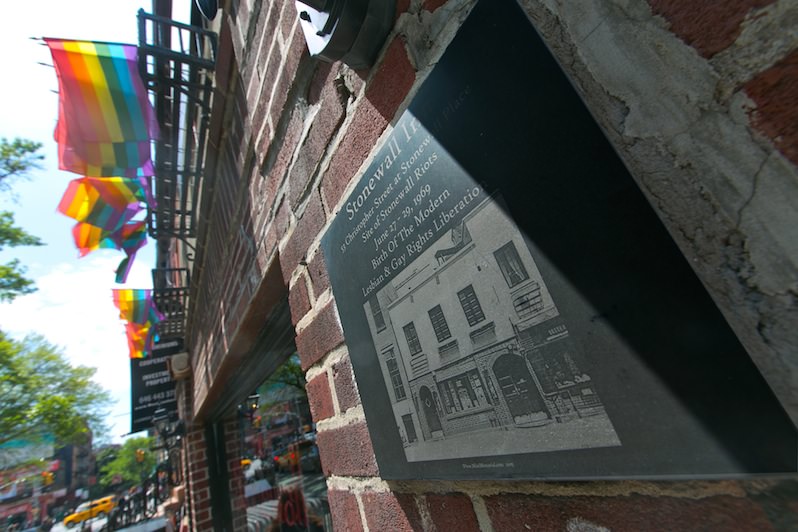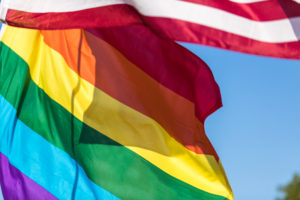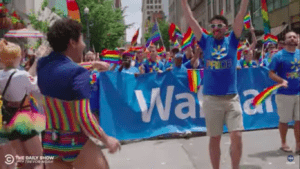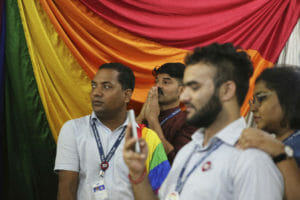The Black Drag Queens Who Fought Before Stonewall
Roland Emmerich’s new film has rightly been criticized for revising and whitewashing the history of the Christopher Street riots. What many of us fail to realize is that the Greenwich Village uprising was not the first chapter in the story of LGBT rights: Courageous rebels of color were fighting for their liberation long before June 28, 1969. A plaque on the front of the Stonewall Inn in New York's Greenwich Village notes the site of the Stonewall uprising. Roland Emmerich’s new film about the events has rightly been criticized for revising and whitewashing history, but what many of us fail to realize is that the Christopher Street riots were not the first chapter in the story of LGBT rights: Courageous rebels of color were fighting for their liberation long before June 28, 1969. (Richard Drew / AP)
A plaque on the front of the Stonewall Inn in New York's Greenwich Village notes the site of the Stonewall uprising. Roland Emmerich’s new film about the events has rightly been criticized for revising and whitewashing history, but what many of us fail to realize is that the Christopher Street riots were not the first chapter in the story of LGBT rights: Courageous rebels of color were fighting for their liberation long before June 28, 1969. (Richard Drew / AP)
When the police burst through the door that night, all the dancing suddenly stopped. The men — adorned in the finest silk and satin dresses — looked on in shock for a brief moment before scurrying to make their getaway.
Many danced about “almost in a nude condition,” The Washington Post reported, as they struggled to strip off their garments, their ribbons and their “wigs of long wavy hair.” Others raced immediately to the back doors or leapt out of second-floor windows and onto the roofs of neighboring buildings.
A large man named William Dorsey Swann — the queen of the ball — was himself “arrayed in a gorgeous dress of cream-colored satin,” but unlike the others, he ran frantically toward the officers in a vain attempt to keep them from entering the two-story residence in northwest Washington, D.C., just half a mile from the White House.
The raid caused such a commotion that roughly 400 people arose from their beds, gathered outside to watch and even followed the police and suspects back to the station that night. In total, 13 men — all black — were arrested and “charged with being suspicious characters.” They were ordered to pay a bond or serve 30 days in jail, and their names were published in the local papers the next day for all the city to read.
It was April 12, 1888, long before the Stonewall uprising or the sexual revolution of the 1960s — by which time many gays, lesbians, bisexuals and transgender people were already living openly and unashamedly in New York, Chicago, San Francisco and other cities.
In the 1880s, however, homosexuality — then known as sexual inversion, erotopathia and “the old Scythian malady” and by other bizarre-sounding names — was often spoken of in the same breath as bestiality and, even among highly educated people, it was nearly unanimously looked upon as both a moral abomination and a serious mental disorder.
If Swann and his companions were alive today, they might proudly declare themselves to be gay or transgender. In doing so, they would receive support and validation for their desires and identities from LGBT people and allies in every sizable American city, including the nation’s capital — not to mention from powerful organizations and people within the legal, political, medical and religious establishments. In 19th-century society, however, the organizers of Washington’s underground drag parties were known simply as deviant men, and it is quite likely that the only support and validation that they could hope for was from one another.
Though some in the group were white, Swann and his friends were mostly black men who worked as laborers for wealthy white families or for the federal government, and despite the ever-present threat of being raided by the police, publicly shamed in the newspapers, fired from their jobs, disowned by their families and sent to prison, they repeatedly gathered in secret in one another’s homes to hold drag dances.
Just a year before, in January 1887, another such dance was also raided. This one had featured both white and black invitees — some sporting fancy frocks and, despite the chilly weather, some wearing nothing at all — and several of the same people had been arrested, including Swann.
The available evidence hints that the men may have intentionally changed the locations of their parties in order to evade law enforcement. Detectives, however, were keeping an eye on Swann and the others, perhaps with the help of one or more informants within the group.
Eventually, on New Year’s Eve of 1895, after the men had successfully eluded the authorities for years, the police abruptly walked into Swann’s home to disrupt a gathering that had only just begun. The officers arrested the host, charging him with keeping a disorderly house. Three black guests were also taken in and charged with vagrancy, while three white guests faced no charges but were summoned as “witnesses.”
Those “witnesses” — identified in The Evening Star newspaper as “young men of respectable parentage” — testified that while attending the party, they had “danced and indulged in strong drink of all kinds, from beer to champagne.” Swann was found guilty and sentenced to 10 months in jail. (The judge, who said Swann’s home had become a “hell of iniquity,” told the court he wished he had had the power to impose a 10-year sentence instead.)
“I would like to send you where you would never again see a man’s face, and would then like to rid the city of all other disreputable persons of the same kind,” the judge declared. “Thieving and petty assaults amount to nothing as compared with the conduct of these people.”
“The conduct of these people” was indeed quite special — but for reasons the police court judge could never have imagined. In fact, “these people” were not only among the nation’s first drag queens, but they were also, more significantly, leading activists in what would eventually become the gay and transgender liberation movements. Arguably, they were rebels whose sacrifices, courage and determination helped lay the foundations of self-acceptance, solidarity and community that made the Stonewall riots possible more than 80 years later.
This past June, as many LGBT Americans enjoyed annual pride celebrations and rejoiced after the Supreme Court’s ruling on marriage equality, we should have taken just a moment to honor the contributions of William Dorsey Swann and his companions — John Smith, Jacob Byard, Charles Myers and so on — men whose names we know today only because society once attempted to shame them into silent defeat. But it is not possible to celebrate people about whom we know nothing. Like so many pioneers in our nation’s past, Swann’s group has nearly been erased from history.
Such erasures continue to this day. On Friday of this week, for example, “Stonewall” — a film directed by Roland Emmerich (a white gay man whose resume includes blockbusters such as “2012,” “Godzilla” and “Independence Day”) — will make its nationwide debut, presenting a condensed, fictionalized version of events that began on June 28, 1969, when a police raid of the Stonewall Inn — a Greenwich Village bar popular among LGBT patrons — led to days of rioting and the beginning of the modern LGBT rights movement.
Then called Christopher Street Gay Liberation Day, the first pride march was held in New York City on June 28, 1970.
The film tells the story of Danny, a young white gay man from Indiana (played by Jeremy Irvine) who moves to New York and ends up becoming embroiled in the uprising. In the process, it minimizes, distorts or eliminates some of the gay and transgender people of color who were central figures in the actual riots.
Marsha P. Johnson, a black transgender activist who is credited with being one of the first to resist the police that night, is only a secondary character. Miss Major Griffin-Gracy, also a trans activist, is not even represented, and two others — the iconic Sylvia Rivera, a founding member of the Gay Liberation Front and other organizations, and Raymond Castro, a gay man of Puerto Rican descent — are merged into one: the gender-fluid Ray/Ramona character (played by Jonny Beauchamp).
Critics also note that not a single transgender actress was cast to play any of the roles. Emmerich has stridently defended the film on social media. He has also insisted that the choice not to cast transgender actors was because those who auditioned (for the part of Marsha P. Johnson) simply were not good enough. (Otoja Abit, a cisgender — or nontransgender — male actor, was cast instead.)
Ashley Love, 35, a journalist and coordinator with the organization Stonewalling Accurate & Inclusive Depictions, is not buying it.
Love, who identifies herself as a black and Latina woman of transsexual and intersex history, told me: “It’s unrealistic to believe no trans actresses were available to play the role of Marsha. To make matters worse, Sylvia Rivera was morphed into the Ray/Ramona character, blatantly misgendered and stripped of her womanhood.”
On Thursday evening, SAID plans to hold a rally outside the Stonewall Inn to educate the public about the film, the history of Stonewall and the contributions of transgender women of color.
But as important as it is that we take Emmerich and other media makers to task for distorting the history of Stonewall, it is even more important that we realize that Stonewall was not actually the beginning of LGBT history — or even the beginning of the LGBT rights movement. Untold numbers of people navigated same-sex desire and transgender identity long before Stonewall, including Swann and his group, who fought daily battles not only to survive but also to create spaces where their spirits could be nurtured.
Jonathan Ned Katz, the author of the seminal work “Gay American History: Lesbians and Gay Men in the U.S.A.,” points out that there were many LGBT heroes who lived in the 19th and 20th centuries whom most of us know nothing about — like Carl Schlegel, a New York pastor who dreamed of starting the first gay organization in 1903.
“As a historian,” Katz told me, “it’s important to note that there were many examples earlier” than Stonewall — including the transgender rioters at Compton’s Cafeteria in San Francisco’s Tenderloin neighborhood in 1966.
But all too often, such acts of resistance seemed to lead nowhere in the short term.
“It took such courage to be part of this movement,” Katz added, because “the society over and over defined you as a freak.”
Kevin Mumford, a professor of history at the University of Illinois, explained that black gay men in particular were often at the forefront of the civil rights and gay liberation movements.
People like Bayard Rustin, the chief organizer of 1963’s March on Washington for Jobs and Freedom, and the author James Baldwin — “were ahead of the curve and were very visible” early on, Mumford said. In Baldwin’s case, “he didn’t always identify with gay liberation, but they always identified with him.”
It is unclear how William Dorsey Swann and the other men who attended the District’s drag parties thought of themselves or their activities. The present-day notion of the homosexual had not yet developed. But whether they would identify with today’s LGBT communities or not, American society is in debt to Swann and his cadre for their sacrifices, their tenacity and their cultural legacy.
In my own research, I have found only a few short newspaper articles — published between 1887 and 1896 — about the dances that Swann and his friends held. The earliest article, from The Evening Star, may very well be the first known description of a drag party in the United States. Such events, held in secret, would later develop into lavish public spectacles in the 1920s and ’30s and, eventually, give rise to the rich cultural traditions documented in “Paris Is Burning,” kept alive in U.S. nightclubs, and celebrated on “RuPaul’s Drag Race” and in many other popular movies, television shows and songs.
Jennie Livingston’s 1990 documentary “Paris Is Burning” offered mainstream Americans a glimpse into New York’s ballroom competitions — which appear to be cultural descendants of 19th-century drag dances.
Though some may continue to downplay our role or cut us out of history, gay and transgender people of color have been present at every stage of LGBT liberation — before, during and after Stonewall. We have always been right there — at the center of the action — no matter what the official history books or the popular memory might suggest — fighting battles that we sometimes could not win in our lifetimes. Sylvia Rivera was quoted saying that there was nowhere else that she would rather be.
At one point, in the midst of the Stonewall uprising, her boyfriend asked her if she wanted to go home for a change of clothes.
“Are you nuts?” she answered. “I’m not missing a minute of this — it’s the revolution!”
Channing Joseph, based in San Francisco, is one of Truthdig’s editors. He frequently writes columns exploring how our nation’s past can shed light on current events. He is also a correspondent for MTV News covering social justice issues and has written for national and international publications.
Your support matters…Independent journalism is under threat and overshadowed by heavily funded mainstream media.
You can help level the playing field. Become a member.
Your tax-deductible contribution keeps us digging beneath the headlines to give you thought-provoking, investigative reporting and analysis that unearths what's really happening- without compromise.
Give today to support our courageous, independent journalists.



You need to be a supporter to comment.